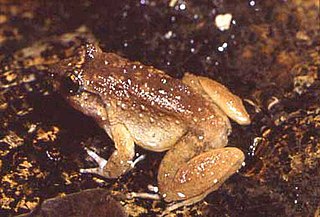
Limnonectes is a genus of fork-tongued frogs of about 75 known species, but new ones are still being described occasionally. They are collectively known as fanged frogs because they tend to have unusually large teeth, which are small or absent in other frogs.
Limnonectes arathooni is a species of frog in the family Dicroglossidae. It is endemic to southwestern Sulawesi, Indonesia.

Limnonectes doriae is a species of frog in the family Dicroglossidae found in the Southeast Asia.
Limnonectes finchi, Finch's wart frog, is a species of frog in the family Dicroglossidae endemic to Sabah, Malaysia, but it might well occur in adjacent Kalimantan. Its natural habitats are tropical moist lowland forests. The main potential threat to this species is habitat loss caused by conversion of forests to oil palm plantations. L. finchi shows some parental care: male frogs guard eggs and carry the tadpoles to small rain pools on the forest floor where the rest of larval development occurs.
Limnonectes fragilis is a species of frog in the family Dicroglossidae. It is endemic to the Hainan Island, China. It is a medium-sized frog, males being 49 mm (1.9 in) and females 52 mm (2.0 in) snout-vent length. Its natural habitats are subtropical or tropical moist lowland forest and rivers. It is threatened by habitat loss.

Limnonectes fujianensis is a species of frog in the family Dicroglossidae. It is most closely related to, and formerly confused with Limnonectes kuhlii. Its name refers to the type locality in Fujian province of China. It is also found in Hunan, Zhejiang, and Jiangxi in China as well as in Taiwan. and other sources give a somewhat broader distribution.

Limnonectes gyldenstolpei is a species of frog in the family Dicroglossidae. It is found in northern Thailand, Laos, and southwestern Cambodia.

Limnonectes ingeri is a species of frog in the family Dicroglossidae. It is found in Borneo . Its natural habitats are tropical moist lowland forests, rivers, and swamps. It is probably seriously affected by habitat loss, and locally also by collection for food.

Limnonectes khasianus, commonly known as the corrugated frog, rivulet frog, or sometimes (ambiguously) called "flat-headed frog", is a species of frog in the family Dicroglossidae. It is found in Brunei, India, Indonesia, Malaysia, Myanmar, Thailand, and possibly Bangladesh and Bhutan. Its natural habitats are subtropical or tropical moist lowland forest, subtropical or tropical moist montane forest, rivers, intermittent rivers, freshwater marshes, and intermittent freshwater marshes. It is not considered threatened by the IUCN.

The Koh Chang frog or Koh Chang wart frog is a species of frog in the family Dicroglossidae. It is found in east Thailand and southern Cambodia. Records from Laos and Vietnam represent other species.

The fanged river frog, Javan giant frog, Malaya wart frog, or stone creek frog is a species of frog in the family Dicroglossidae endemic to Sumatra and Java, Indonesia. Records from other regions are probably caused by misidentifying other species such as Limnonectes blythii as this species.

Limnonectes macrognathus is a species of frog in the family Dicroglossidae. It is found in Malaysia, Myanmar and Thailand. Its natural habitats are subtropical or tropical moist lowland forests, rivers and intermittent rivers. Its status is insufficiently known.

The giant Philippine frog, large swamp frog, or Mindanao fanged frog is a species of frog in the family Dicroglossidae. It is endemic to the Philippines. Its natural habitats are tropical moist lowland forests, subtropical or tropical moist montane forests, rivers, intermittent rivers, freshwater marshes, and intermittent freshwater marshes. It is becoming rare due to habitat loss.
The Malesian frog, Malaysian river frog, Malaysian peat frog, or peat swamp frog is a species of frog in the family Dicroglossidae. It is found on the Malay Peninsula, Sumatra, Java, Borneo, and a range of islands on the Sunda Shelf . Its natural habitats are shallow, gentle streams and nearby swampy areas including peat swamps, very flat alluvial forests, and overgrown plantations. It is becoming rare due to habitat loss (deforestation), and to a lesser extent, exploitation.

Limnonectes microtympanum is a species of frog in the family Dicroglossidae. It is endemic to Sulawesi, Indonesia, where it is only known from the Moncong Lompobatang mountain at elevations above 1,000 m (3,300 ft).

Limnonectes namiyei is a species of frog in the family Dicroglossidae. It is endemic to Okinawa Island, Japan. It is named after Motoyoshi Namiye, a Japanese naturalist and herpetologist. Its common name is Okinawa wart frog or Namiye's frog; the latter name is also spelled Namie's frog.
Limnonectes nitidus is a species of frog in the family Dicroglossidae. It is endemic to Peninsular Malaysia where it is only known from the Cameron Highlands and Fraser's Hill, both in Pahang state.

Limnonectes paramacrodon is a species of frog in the family Dicroglossidae. It is found in Malay Peninsula, Borneo, and Natuna Besar. Its natural habitats are lowland swamp forest areas with small rivers and streams. It is becoming rare due to habitat loss.
Limnonectes shompenorum is a species of frog in the family Dicroglossidae. It is found in Great Nicobar Island (India), its type locality, and in western Sumatra (Indonesia). It is similar to Limnonectes macrodon. The name refers to Shompen people, the indigenous people of the interior of Great Nicobar Island.
Limnonectes tweediei is a species of frogs in the family Dicroglossidae. It is found in Sumatra (Indonesia) and the Malay Peninsula (Malaysia).













